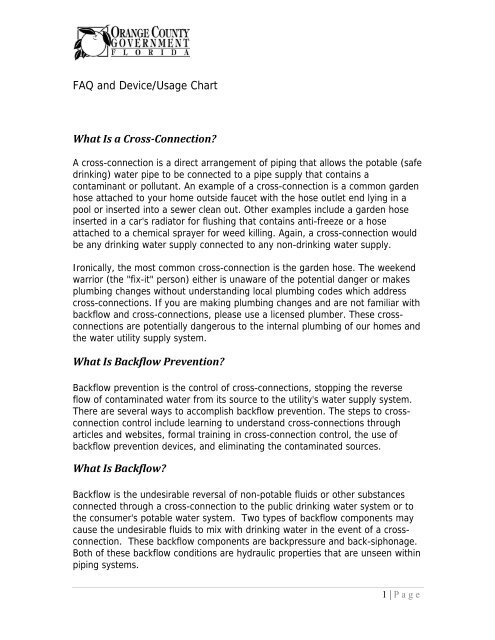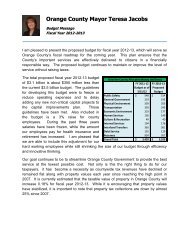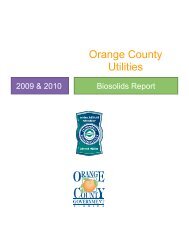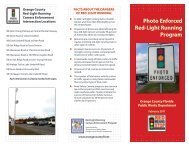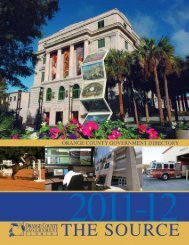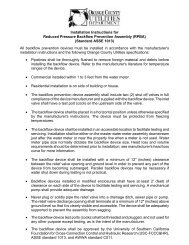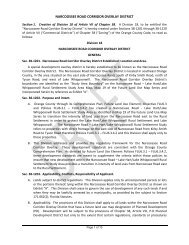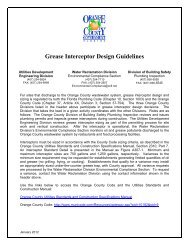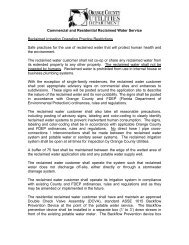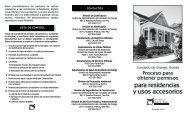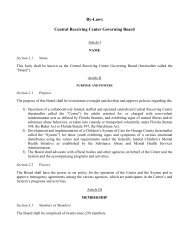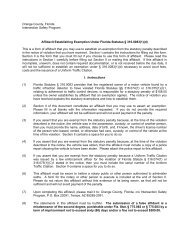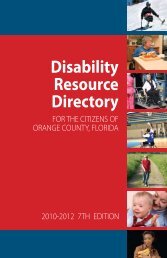What Is a Cross-Connection? - OrangeCountyFl.net
What Is a Cross-Connection? - OrangeCountyFl.net
What Is a Cross-Connection? - OrangeCountyFl.net
Create successful ePaper yourself
Turn your PDF publications into a flip-book with our unique Google optimized e-Paper software.
FAQ and Device/Usage Chart<br />
<strong>What</strong> <strong>Is</strong> a <strong>Cross</strong>-<strong>Connection</strong>?<br />
A cross-connection is a direct arrangement of piping that allows the potable (safe<br />
drinking) water pipe to be connected to a pipe supply that contains a<br />
contaminant or pollutant. An example of a cross-connection is a common garden<br />
hose attached to your home outside faucet with the hose outlet end lying in a<br />
pool or inserted into a sewer clean out. Other examples include a garden hose<br />
inserted in a car's radiator for flushing that contains anti-freeze or a hose<br />
attached to a chemical sprayer for weed killing. Again, a cross-connection would<br />
be any drinking water supply connected to any non-drinking water supply.<br />
Ironically, the most common cross-connection is the garden hose. The weekend<br />
warrior (the "fix-it" person) either is unaware of the potential danger or makes<br />
plumbing changes without understanding local plumbing codes which address<br />
cross-connections. If you are making plumbing changes and are not familiar with<br />
backflow and cross-connections, please use a licensed plumber. These crossconnections<br />
are potentially dangerous to the internal plumbing of our homes and<br />
the water utility supply system.<br />
<strong>What</strong> <strong>Is</strong> Backflow Prevention?<br />
Backflow prevention is the control of cross-connections, stopping the reverse<br />
flow of contaminated water from its source to the utility's water supply system.<br />
There are several ways to accomplish backflow prevention. The steps to crossconnection<br />
control include learning to understand cross-connections through<br />
articles and websites, formal training in cross-connection control, the use of<br />
backflow prevention devices, and eliminating the contaminated sources.<br />
<strong>What</strong> <strong>Is</strong> Backflow?<br />
Backflow is the undesirable reversal of non-potable fluids or other substances<br />
connected through a cross-connection to the public drinking water system or to<br />
the consumer's potable water system. Two types of backflow components may<br />
cause the undesirable fluids to mix with drinking water in the event of a crossconnection.<br />
These backflow components are backpressure and back-siphonage.<br />
Both of these backflow conditions are hydraulic properties that are unseen within<br />
piping systems.<br />
1 | Page
FAQ and Device/Usage Chart<br />
<strong>What</strong> <strong>Is</strong> Backpressure Backflow?<br />
Backpressure backflow is when a cross-connection of a non-potable fluid has a<br />
greater pressure than the public water supply system. A cross-connection<br />
between the consumer's water service and the public water system could push<br />
these unwanted contaminants or pollutants into the drinking water supply. An<br />
auxiliary water source (reclaimed water, fire suppression system, lake, canal, or<br />
well) fitted with a pump could create backpressure onto the drinking water side.<br />
Backpressure may occur when the County's water supply pressure is 60 pounds<br />
per square inch (60 psi), and it is connected through a cross-connection to<br />
higher temperature water in a boiler or high-rise building at 80 psi. The greater<br />
pressure of 80 psi will force its way into the public water system. As stated, a<br />
backpressure hazard may include a cross-connection with a pump to a private<br />
well, reclaimed water, or lake water used for irrigation. The consumer is normally<br />
unaware of these dangerous cross-connections.<br />
<strong>What</strong> <strong>Is</strong> Back-Siphonage?<br />
Back-siphonage is a condition caused by negative pressure (vacuum) within the<br />
utility water system. Back-siphonage can be caused by a broken water main. A<br />
water outage reduces water pressure within a building and the water distribution<br />
system, often causing a reversal of water flow. Fighting a fire may also cause<br />
reversal of flow in water mains by withdrawing large amounts of water very<br />
quickly. It causes low pressure to be seen in other parts of the system.<br />
Remember that liquids will flow toward the lowest pressure, so if the lowest<br />
pressure is the broken water main, all cross-connection waters will try to reach<br />
that point and create a vacuum.<br />
Why <strong>Is</strong> Backflow Prevention Important?<br />
With the ongoing articles about backflow prevention and cross-connection<br />
control, you have seen that the water supplier needs to protect the public water<br />
supply against backflow contamination or pollution.<br />
Backflow of water can make the water system unusable or unsafe to drink. Each<br />
water supplier has a responsibility to provide water that is safe to drink under all<br />
foreseeable circumstances. Furthermore, consumers generally have absolute<br />
faith that the water delivered to them through a public water system is always<br />
2 | Page
FAQ and Device/Usage Chart<br />
safe to drink. For these reasons, each water supplier must take reasonable<br />
precaution to protect its drinking water supply against backflow.<br />
The water supplier usually does not have the authority or capability to repeatedly<br />
inspect every water service for cross-connections and backflow. Each water<br />
supplier should ensure that a backflow preventer is installed and maintained at<br />
the water service connection to each premise that poses a significant health<br />
hazard. This includes dedicated fire lines, irrigation systems, reclaimed water<br />
users, auxiliary waters (lakes/ponds/canals), and commercial customers.<br />
Local plumbing codes require backflow preventers to every water outlet (Air-Gap<br />
or Hose <strong>Connection</strong> Vacuum Breakers). These backflow devices are within the<br />
internal plumbing system on every building or home. Because these internal<br />
devices are not always installed correctly or even tested, the water supplier will<br />
require a containment device to be placed at the water meter to contain any<br />
backflow within the property or building and in return protect the community<br />
water supply system.<br />
<strong>What</strong> Are the Methods or Mechanisms Used to Prevent Backflow?<br />
The basic method is the Air-Gap. This Air-Gap provides a physical vertical air<br />
barrier, a physical separation between the end of a water supply outlet (pipe)<br />
and the flood rim of a receiving tank or vessel. This separation must be at least<br />
twice the diameter of the pipe supply line but never less than one inch. An Air-<br />
Gap is considered the maximum protection against backpressure backflow, backsiphonage<br />
backflow, and toxic conditions because there are no mechanical<br />
components to break down. This Air-Gap should be inspected annually because it<br />
can be easily by-passed. We see this Air-Gap used every day in the kitchen sink<br />
and our utility water hauling vehicles. The Air-Gap is not always practical<br />
because it will not supply water pressure, only water.<br />
<strong>What</strong> <strong>Is</strong> a Reduced Pressure Principle Backflow Assembly (RPZ)?<br />
A mechanical backflow preventer that can be used for backpressure backflow,<br />
back-siphonage backflow, and toxic conditions is the Reduced Pressure Principle<br />
Backflow Assembly(RPZ). This RPZ has two independent spring-loaded check<br />
valves and a pressure differential relief valve between the check valves. The RPZ<br />
device includes shutoff valves and is equipped with test ports for annual testing.<br />
3 | Page
FAQ and Device/Usage Chart<br />
The relief valve will open if either check valve fails and will harmlessly dump any<br />
backflow water to the ground, thus, backflow water or contaminated fluids never<br />
reach the public water supply system. This device is subject to failure as with<br />
anything mechanical, so annual testing is required. Installation is normally on<br />
commercial accounts at the water meter and must be installed 12 inches above<br />
ground or flood level.<br />
<strong>What</strong> <strong>Is</strong> a Double Check Valve Assembly (DC)?<br />
The Double Check Valve Assembly backflow preventer is a mechanical device<br />
that consists of two independently acting, spring-loaded check valves. This<br />
device includes shutoff valves at each end of the assembly and is equipped with<br />
test ports. The Double Check Valve Assembly does not include a relief valve as<br />
with the Reduced Pressure Principle device. On the Double Check Valve<br />
Assembly, if the second check valve fails, the first check valve is a backup. The<br />
Double Check Valve Assembly is effective against backpressure and backsiphonage<br />
but should be used only to isolate pollutant (non-health/non-toxic)<br />
conditions. The Double Check Valve Assembly can be used to protect against<br />
aesthetically objectionable hazard locations, such as non-chemical businesses,<br />
non-chemical irrigation injection systems, commercial and residential accounts<br />
with a low risk hazard, reclaimed water areas, and clothing, food, or steam<br />
facilities. The Double Check Valve Assembly is normally installed 12 inches<br />
above the ground level or below ground in a separate box with test ports<br />
plugged. This device is subject to failure, as with anything mechanical, so<br />
annual testing is required by the utility to ensure the drinking water system is<br />
protected.<br />
<strong>What</strong> <strong>Is</strong> a Pressure Vacuum Breaker (PVB)?<br />
A Pressure Vacuum Breaker (PVB) backflow preventer is a mechanical device<br />
that consists of one independently acting, spring-loaded check valve and an<br />
independently acting spring-loaded air inlet valve on the discharge side of the<br />
device. This device includes shutoff valves at each end of the assembly and is<br />
equipped with test ports. A PVB may be used to isolate health or non-health<br />
hazards but is only effective on back-siphonage conditions. Backpressure<br />
applications should be avoided. Normal applications would include isolation<br />
protection to an irrigation system and located at or near the exterior of a<br />
building. The PVB shall be installed 12 inches above the highest water outlet.<br />
During a back-siphonage condition (vacuum) the PVB will close the bottom check<br />
4 | Page
FAQ and Device/Usage Chart<br />
valve and the air inlet will open to let air enter the device to break the vacuum.<br />
This device is subject to failure as with anything mechanical, so annual testing is<br />
required.<br />
<strong>What</strong> <strong>Is</strong> a Hose <strong>Connection</strong> Vacuum Breaker, Backflow Through<br />
Back-Siphonage?<br />
Hose <strong>Connection</strong> Vacuum Breaker, Backflow through Back-Siphonage is a form of<br />
backflow that is the reversal of normal water flow to your home or business<br />
caused by a negative pressure (vacuum) in the water supply system. Backsiphonage<br />
can be created when the water supply piping is cut (main break) or<br />
during periods of high velocity water flow due to nearby fire fighting. If our<br />
homes lack the required backflow prevention devices (hose bibb vacuum<br />
breakers) or irrigation protection, contaminants can be back-siphoned into either<br />
the house plumbing or the utility's water supply system.<br />
A situation common to most homeowners involves chemical aspirators, which are<br />
used to spray fertilizer or pesticides on yards or flower gardens. These are often<br />
attached to garden hoses, which may not have hose bibb vacuum breakers for<br />
protection. A back-siphonage condition could cause chemicals from the aspirators<br />
to be pulled into the house plumbing, thus, hose bibb vacuum breakers are<br />
required by all plumbing codes within the United States. Without the use of<br />
containment devices, hose bibb vacuum breakers are the utility and<br />
homeowner's first line of defense in prevention of backflow prevention.<br />
Plumbing and water utility inspectors survey for these inexpensive devices, which<br />
are simply attached to threaded faucets, sill cocks or any pipe threaded for hose<br />
attachment. Similar to atmospheric vacuum breakers, hose bibb vacuum<br />
breakers should not be used in situations where backpressure could occur. In the<br />
past, some hose bibb vacuum breakers manufactured in foreign countries have<br />
not met nationally approved standards, such as ASSE 1011, CSA B64.2 and<br />
IAPMO.<br />
Freezing conditions may require hose bibb vacuum breaker models made with a<br />
drainage stem, which permit drainage during winter months. Removable-type<br />
hose bibb vacuum breakers have a potential problem, because they may not be<br />
reinstalled after winter. To prevent removal of these vacuum breakers, lock tight<br />
setscrew or twist lock devices provide for permanent installation. <strong>Cross</strong>connections,<br />
either back-siphonage (vacuum) or backpressure (higher pressure<br />
5 | Page
FAQ and Device/Usage Chart<br />
than the distribution pressure, caused by an auxiliary pump) are possible. It is<br />
imperative that each water service connection is in compliance with all plumbing<br />
codes. Hose connection vacuum breakers meeting ASSE 1011 standards are<br />
required by plumbing codes on all threaded hose connections<br />
How Do I Select the Proper Device?<br />
CONDITION<br />
Double Check<br />
Valve Assembly<br />
(DCVA ASSE<br />
1015)<br />
Reduced<br />
Pressure<br />
Principle (RP)<br />
ASSE 1013<br />
Pressure<br />
Vacuum<br />
Breaker<br />
(PVB)<br />
ASSE<br />
1020<br />
Atmospheric<br />
Vacuum Breaker<br />
(AVB) ASSE 1001<br />
Air Gap<br />
(AG)<br />
BACK PRESSURE x x x<br />
BACK<br />
SIPHONAGE<br />
x x x x x<br />
TOXIC<br />
(high hazard)<br />
x x x<br />
NON TOXIC<br />
(low hazard)<br />
x x x x x<br />
CONTINUOUS<br />
SUPPLY<br />
PRESSURE<br />
x x x<br />
No more than 12<br />
hours<br />
INSTALL<br />
LEVEL<br />
12" above grade Relief valve 12"<br />
above grade<br />
12"<br />
above<br />
highest<br />
water<br />
outlet<br />
6" above highest<br />
water outlet<br />
2x pipe<br />
diameter.<br />
Not less<br />
than 1"<br />
6 | Page


